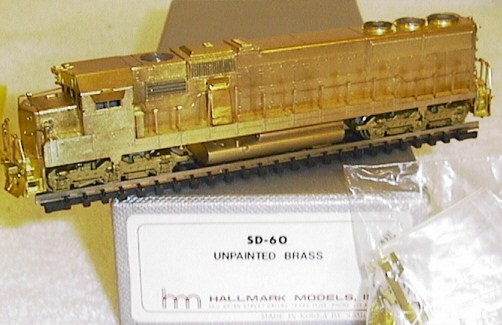| SD45-2 | SD45B-2 |
 |  |
| SD45T-2 | SD50 |
 | |
| SD60 | SD60M |
 |  |
| SD45-2 | SD45B-2 |
 |  |
| SD45T-2 | SD50 |
 | |
| SD60 | SD60M |
 |  |
Introduced: 1989
These models all came out around the same time, and as such I'm going to go ahead and assume they all share the same basic internals. So, to save myself a bit of time I'm going to cover them all here.
Internally, these locos are a real departure from Samhongsa's typical diesel design of the 80s and 90s. In fact, the mechanism employed here is clearly an out-and-out copy of the design Kato used in their GP38-2 and GP50 diesels of the late 80s -

The walkway assembly is sandwiched between the mechanism frame and the trucks (with long screws holding the whole assembly together). The mechanism frame is a single chunk of metal and quite hefty. It holds the motor, multi-piece plastic driveshafts and combo worm / flywheel gears. Like the aforementioned Kato diesels, each worm gear actually has flywheels built into either end (for a total of four). The motor is an open-sided, straight-wound 5-poler. All 12 wheels collect current, which flows into the metal truck halves and into bronze contacts screwed to the bottom of the chassis. Current is routed from said contacts to the motor via a couple of wires. All axles are geared and all gearing is plastic. There is no window glazing or couplers (although MicroTrains-friendly coupler pockets are provided). There isn't any lighting either, however lighting-friendly channels are provided in the top of the mechanism frame.
These are easily the finest running Samhongsa diesels I've yet encountered (not surprising, give the Kato-inspired design). They run smoothly and, for the most part, very quietly (although the motor does tend to growl a bit at extremely low speeds). Pickup is flawless and slow-speed creep is quite excellent. The top end speed is extremely realistic (for a change). And despite the three-axle trucks, mine has no problems navigating narrow radius curves. Wheels are low-profile, so no problems on Code 55 rails. The giant metal chassis provides plenty of heft for superior pulling power. Overall, these are gorgeous looking brass diesels that run every bit as good as they look.
The "B" units are pretty hard to find, with perhaps as few as 50 of them having been made. The very rarely show up on eBay.
Removing the locomotive shell involves finding and unscrewing five tiny screws on the bottom of the chassis - two behind the rear truck, one in front of the forward truck, and one on either side of the forward truck. Once removed, the shell should lift right off (just be sure to free the four handrails that connect to the cab first). The four large screws on the bottom of the chassis actually hold the mechanism frame, trucks and walkway assembly together. They need not be removed if all you want to do is take off the shell.
Grade: A